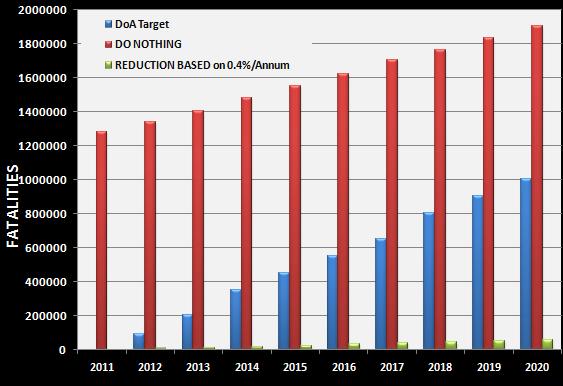Are there any indications that the decade of action is making good progress towards meeting its targets?
Not so far.
Bloomberg Philanthropies stated (2010-2012 mid-term report) http://ebookbrowsee.net/rs10-brox-pdf-d627953704
“We estimate that at least 12,670 lives will be saved based on our early accomplishments”.
That is 12,670 lives saved out of 3,000,000 deaths (a five year period) at a cost of $US125 million. That is approximately $US10,000 for each life saved and the estimated fatality reduction is 0.4%.
If this is an obtainable reduction world wide then the target for the Decade of Action will not be reached. The figure should be nearer 25% at this stage of the decade to achieve the target reduction. The chart below illustrates possible progress.
It should also be born in mind that world traffic growth and the associated increase in fatalities will further make the target difficult if not impossible to achieve in the close future.
The work of Kopits and Cropper is important to understanding the major factors impacting on traffic crash reduction.
Traffic Fatalities and Economic Growth Authors: Elizabeth Kopits and Maureen Cropper Published: April 2003 Pages: 48 Complete Book PDF (333KB)
Abstract:
“Kopits and Cropper examine the impact of income growth on the death rate due to traffic fatalities, as well as on fatalities per motor vehicle and on the motorization rate (vehicles/population) using panel data from 1963–99 for 88 countries.
Specifically, they estimate fixed effects models for fatalities/population, vehicles/population, and fatalities/vehicles and use these models to project traffic fatalities and the stock of motor vehicles to 2020. The relationship between motor vehicle fatality rate and per capita income at first increases with per capita income, reaches a peak, and then declines.
This is because at low income levels the rate of increase in motor vehicles outpaces the decline in fatalities per motor vehicle. At higher income levels, the reverse occurs. The income level at which per capita traffic fatalities peaks is approximately $8,600 in 1985 international dollars. This is within the range of income at which other externalities, such as air and water pollution, have been found to peak.
Projections of future traffic fatalities suggest that the global road death toll will grow by approximately 66 percent between 2000 and 2020. This number, however, reflects divergent rates of change in different parts of the world—a decline in fatalities in high-income countries of approximately 28 percent versus an increase in fatalities of almost 92 percent in China and 147 percent in India. The authors also predict that the fatality rate will rise to approximately 2 per 10,000 persons in developing countries by 2020, while it will fall to less than 1 per 10,000 in high-income countries. This paper—a product of Infrastructure and Environment, Development Research Group—is part of a larger effort in the group to study the externalities associated with motorization.“











